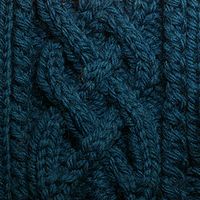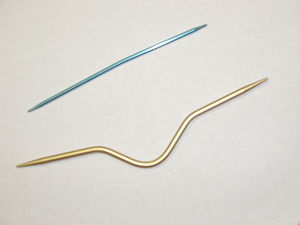
Cable knitting
Encyclopedia

Knitting
Knitting is a method by which thread or yarn may be turned into cloth or other fine crafts. Knitted fabric consists of consecutive rows of loops, called stitches. As each row progresses, a new loop is pulled through an existing loop. The active stitches are held on a needle until another loop can...
in which textures of crossing layers are achieved by permuting
Permutation
In mathematics, the notion of permutation is used with several slightly different meanings, all related to the act of permuting objects or values. Informally, a permutation of a set of objects is an arrangement of those objects into a particular order...
stitches. For example, given four stitches appearing on the needle in the order ABCD, one might cross the first two (in front of or behind) the next two, so that in subsequent rows those stitches appear in the new order CDAB.
Methods

Cable knitting usually produces a fabric that is less flexible and more dense than typical knitting, having a much narrower gauge
Gauge (knitting)
In knitting, the word gauge is used both in hand knitting and machine knitting; the latter, technical abbreviation GG, refers to "Knitting Machines" fineness size. In both cases, the term refers to the number of stitches per inch, not the size of the finished garment...
. This narrow gauge should be considered when changing from the cable stitch to another type of knitted fabric. If the number of stitches is not reduced, the second knitted fabric may flare out or pucker, due to its larger gauge. Thus, ribbed cuffs on an aran sweater may not contract around the wrist or waist, as would normally be expected. Conversely, stitches may need to be added
Increase (knitting)
In knitting, an increase is the creation of one or more new stitches, which may be done by various methods with distinctive looks.-Methods of Single Increasing :...
to maintain the gauge when changing from another knitted fabric such as stocking to a cable pattern.
Cables are usually done in stocking stitch and surrounded with reverse stocking; this causes the cables to stand out against a receding background. But any combination will do; for example, a background seed stitch
Basic knitted fabrics
A few types of knitted fabric are so fundamental that they have been adopted as part of the language of knitting, similar to techniques such as yarn over or decrease...
in the regions bounded by cables often looks striking. Another visually intriguing effect is meta-cabling, where the cable itself is made up of cables, such as a three-cable plait made of strands that are themselves 2-cable plaits. In such cases, the "inner" cables sometimes go their separate ways, forming beautiful, complex patterns such as the branches of a tree. Another interesting effect is to have one cable "pierce" another cable, rather than having it pass over or under the other.
Two cables should cross each other completely in a single row because making an intermediate crossing row of fewer stitches look good is very difficult. For example, where a pair of three-stitch-wide cables cross, all three stitches of one should cross over the three of the other cable.
Cable braids
Cables are often used to make braid patterns. Usually, the cables themselves are with a knit stitch while the background is done in purl. As the number of cables increases, the number of crossing patterns increases, as described by the braid groupBraid group
In mathematics, the braid group on n strands, denoted by Bn, is a group which has an intuitive geometrical representation, and in a sense generalizes the symmetric group Sn. Here, n is a natural number; if n > 1, then Bn is an infinite group...
. Various visual effects are also possible by shifting the center lines of the undulating cables, or by changing the space between the cables, making them denser or more open.
A one-cable serpentine is simply a cable that moves sinusoidally left and right as it progresses. Higher-order braids are often made with such serpentines crossing over and under each other.
A two-cable braid can look like a rope, if the cables always cross in the
same way (e.g., left over right). Alternatively, it can look like two serpentines, one on top of the other.
A three-cable braid is usually a simple plait (as often seen styled in long hair), but can also be made to look like the links in a chain, or as three independent serpentines.
A four-cable braid allows for several crossing patterns.
The five-cable braid is sometimes called the Celtic princess braid, and is visually interesting because one side is cresting while the other side is in a trough. Thus, it has a shimmering quality, similar to a kris
Kris
The kris or keris is an asymmetrical dagger or sword nowadays most strongly associated with the culture of Indonesia, but also indigenous to Malaysia, Southern Thailand and Brunei. It is known as kalis in the southern Philippines. The kris is famous for its distinctive wavy blade , but many have...
dagger.
The six-cable braid is called a Saxon braid, and looks square and solid. This is a large motif, often used as a centerpiece of an aran sweater or along the neckline
Neckline
The neckline is the top edge of a garment that surrounds the neck, especially from the front view. Neckline also refers to the overall line between all the layers of clothing and the neck and shoulders of a person, ignoring the unseen undergarments....
and hemline
Hemline
The hemline is the line formed by the lower edge of a garment, such as a skirt, dress or coat, measured from the floor.The hemline is perhaps the most variable style line in fashion, changing shape and ranging in height from hip-high to floor-length...
s.
The seven-cable braid is rarely used, possibly because it is very wide.
It may be helpful to think of a cable pattern as a set of serpentine or wave-like cables, each one meandering around its own center line. A vast variety of cable patterns can be invented by changing the number of cables, the separations of their center lines, the amplitudes of their waves (i.e., how far they wander from their center line), the shape of the waves (e.g., sinusoidal versus triangular), and the relative position of the crests and troughs of each wave (e.g., is one wave cresting as another is crossing its center line?).
New cable patterns can also be inspired by pictures, scenes from nature, Celtic knotwork, and even the double helix of DNA
DNA
Deoxyribonucleic acid is a nucleic acid that contains the genetic instructions used in the development and functioning of all known living organisms . The DNA segments that carry this genetic information are called genes, but other DNA sequences have structural purposes, or are involved in...
.
Cable lattices
In some cases, one can form a latticeLatticework
Latticework is a framework consisting of a criss-crossed pattern of strips of building material, typically wood or metal. The design is created by crossing the strips to form a network...
of cables, a kind of ribbing made of cables where the individual cable strands can be exchanged freely. A typical example is a set of parallel 2-cable plaits in which, every sooften, the two cables of each plait separate, going left and right and integrating themselves in the neighboring cables. In the process, the right-going cable of one plait crosses the left-going cable of its neighbor, forming an "X".
Cable textures
Many patterns made with cables do not have a rope-like quality. For example, a deep honeycomb pattern can be made by adjacent serpentines, first touching the neighbor on the left then the neighbor on the right. Other common patterns include a "Y"-like shape (and its inverse) and a horseshoe crabHorseshoe crab
The Atlantic horseshoe crab, Limulus polyphemus, is a marine chelicerate arthropod. Despite its name, it is more closely related to spiders, ticks, and scorpions than to crabs. Horseshoe crabs are most commonly found in the Gulf of Mexico and along the northern Atlantic coast of North America...
pattern.
Aran sweaters
Many consider cable knitting to reach its heights in the Aran sweaterAran sweater
The Aran sweater is a style of jumper/sweater that takes its name from the Aran Islands off the west coast of Ireland. It is sometimes known as a fisherman sweater...
, which consists of panels of different cable patterns.
External links
- Vogue Knitting: The Ultimate Knitting Book, updated ed., Sixth and Spring Books. ISBN-X (2002)
- Reader's Digest Complete Guide to Needlework, Reader's Digest Association. ISBN (1979)
- June Hemmons Hiatt (1988) The Principles of Knitting, Simon & SchusterSimon & SchusterSimon & Schuster, Inc., a division of CBS Corporation, is a publisher founded in New York City in 1924 by Richard L. Simon and M. Lincoln Schuster. It is one of the four largest English-language publishers, alongside Random House, Penguin and HarperCollins...
, pp. 41–51. ISBN - Leapman, Melissa (2006) Cables Untangled: An Exploration of Cable Knitting , PotterCraft. ISBN
- Irish Cable Knitting Aran: Volume One and Volume Two, Snopek Barta, Allison (2009)
- (Vicdeo) How to cable stitch, Irish Cable Knitting (2009) on YouTubeYouTubeYouTube is a video-sharing website, created by three former PayPal employees in February 2005, on which users can upload, view and share videos....

